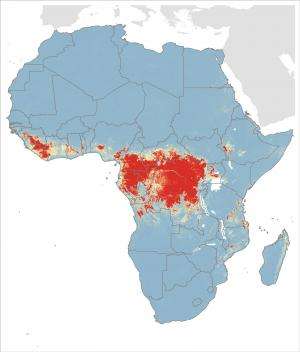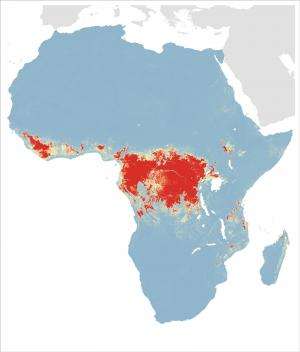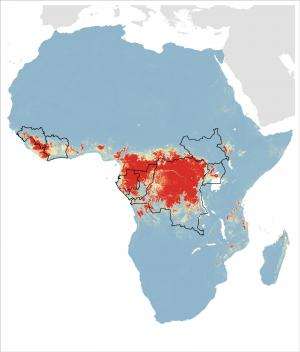Risk of Ebola emergence mapped

A new map identifies areas where animals are likely to be infected with the Ebola virus as a first step towards understanding where future outbreaks of the disease may occur.
The map, based on a model created by a team led by Oxford University scientists, predicts that in animal populations the Ebola virus is likely to be circulating across a vast swathe of forested Central and West Africa. This area covers 7 countries which have already reported Ebola transmission from animals to humans, as well as 15 more countries which are likely to be at risk.
A report of the research is published today in the open access journal eLife.
So far there have been only 30 confirmed cases of Ebola transmission from animals to humans –most instances of transmission are thought to arise from close contact through hunting or butchering infected animals. However, current international efforts to control outbreaks of Ebola in humans in West Africa, and reports of a separate outbreak in the Democratic Republic of the Congo, highlight the importance of being prepared for future outbreaks of the disease so that they can be stopped early.
Whilst rare as a human disease, Ebola virus is thought to be present in many animal populations, especially bats, which can carry the virus without it being lethal to them. The Oxford-led team generated the model by bringing together available data on where human and animal infections have occurred from 1976 to the present and looking for similarities in environmental factors such as vegetation, elevation, temperature, and estimated distribution of bat populations. The researchers were then able to create a map identifying similar areas where the virus is likely to be carried by animals and there is a risk of transmission to humans triggering future outbreaks.
'Although the disease may be found in animals across a wide area, outbreaks are still very rare; very few animals in this region have detectable infections and it is extremely rare for humans to catch the disease from them' said David Pigott of Oxford University's Department of Zoology, one of the lead authors of the study.
'Our map shows the likely 'reservoir' of Ebola virus in animal populations and this is larger than has been previously appreciated. This does not mean that transmission to humans is inevitable in these areas; only that all the environmental and epidemiological conditions suitable for an outbreak occur there' said author Nick Golding, of Oxford University's Department of Zoology. 'Gaining a better understanding of where people are coming into contact with these infected animals, for example through hunting, and how to protect those at risk from Ebola is crucial to preventing future outbreaks.'
Despite the ongoing epidemic in Guinea being a long way from previous outbreaks in Central Africa, the model suggests that the forested areas in which it started are very similar. Likewise, the recent reported cases in the Democratic Republic of the Congo also lie close to areas predicted to contain infected animals.

Bats are thought to be a major carrier of the virus. It has so far been found in three different species of fruit bat; the hammer-headed bat (Hypsignathus monstrosus), Franquet's epauletted fruit bat (Epomops franqueti), and the little collared fruit bat (Myonycteris torquata), though other species may also carry the disease. Nick Golding said: 'Unfortunately we have a very poor understanding of exactly where these bat species are found and which populations are infected. We believe that bats in areas that are likely to be at risk should be tested for Ebola virus, to better understand the threat to local people.'

As with all Ebola virus outbreaks the current one began when a human came into contact with an infected animal, most likely a fruit bat. Understanding where infected animals are present is the first step towards identifying areas where outbreaks are likely to start and where to target the resources and training required to identify and contain them in their early stages.
Countries in 'at risk' region identified by model:
Set 1 (predicted at risk and reported human index cases):
- Democratic Republic of the Congo
- Guinea
- Uganda
- Côte d'Ivoire
- Gabon
- Congo
- South Sudan
Set 2 (predicted at risk but no reported human index cases):
- Nigeria
- Cameroon
- Central African Republic
- Ghana
- Liberia
- Sierra Leone
- Angola
- Togo
- United Republic of Tanzania
- Ethiopia
- Mozambique
- Burundi
- Equatorial Guinea
- Madagascar
- Malawi
More information: The research report is available online: elifesciences.org/content/elif … eLife.04395.full.pdf

















